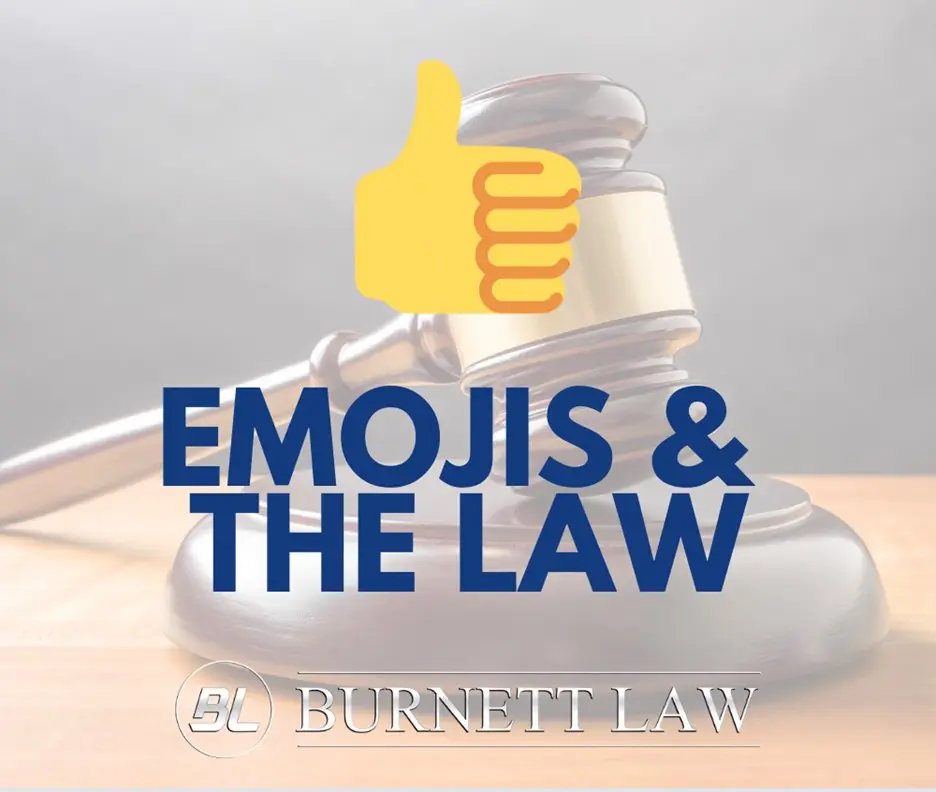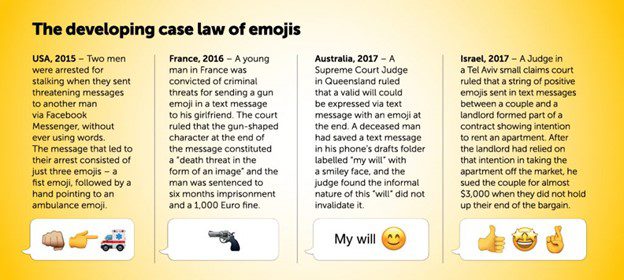Emojis in Court 👍 Navigating the Nuances of Digital Communication
Emojis have become a ubiquitous form of communication, permeating our texts, emails, and social media interactions. Emojis have been around since 1999, but it wasn’t until 2011 when Apple added the official emoji keyboard to iOS and Facebook adopted them as forms of engagement in 2013, that we really saw them take off.

These small, expressive icons add an extra layer of emotion and context to our communications. However, the rise of emojis has not been limited to casual conversations alone. Emojis have started making their way into the legal arena, creating intriguing challenges and raising questions about their impact on court rulings. In this blog, we will explore the relationship between emojis and legal rulings in court, examining recent laws and precedents, including the intriguing case of a Canadian farmer’s thumbs-up emoji and its costly implications.
Emojis as a Form of Expression
Emojis were originally created in 1999 by Japanese designer, Shigetaka Kurita, as a means of enhancing digital communication by conveying emotions that may otherwise be lost in the absence of non-verbal cues.
In fact the word “emoji” means picture and word.
Kurita created a 176 character emoji set in 1999 for DOCOMO’s mobile platform “i-mode.” His intention was to design a simple set of characters for users to convey information in a concise way.
They serve as visual representations of facial expressions, gestures, objects, and symbols, adding layers of meaning and nuance to our written words. As emojis gained popularity, they began to transcend personal conversations and infiltrate professional and legal spheres, leading to unforeseen legal consequences

The Canadian Case: The Power of a Thumbs-Up Emoji
In a recent notable case, a Canadian farmer, Chris Achter, found himself embroiled in a legal dispute over the interpretation of a thumbs-up emoji. Achter had received a contract from a grain buyer via text message, and in response, he sent a thumbs-up emoji. The grain buyer argued that the emoji indicated acceptance of the contract’s terms, while Achter maintained that it simply signified acknowledgment of receipt. The court ruled in favor of the grain buyer, holding that the thumbs-up emoji constituted approval of the contract. As a result, Achter was ordered to pay a substantial amount of $82,200 in Canadian dollars for breach of contract.
The Significance of the Canadian Ruling
What does this mean for Middle Tennesseans? The ruling in Achter’s case highlights the growing importance of digital communication and the potential legal implications of seemingly innocuous emojis. Although this ruling does not provide a definitive interpretation of what a thumbs-up emoji means in all cases, it serves as a crucial reminder that emojis can carry significant legal weight. Currently in the United States and Canada, their interpretation depends on the context, the intentions of the parties involved, and the facts of the case.
Challenges and Interpretation Issues
One of the main challenges surrounding emojis in legal proceedings is their subjective nature. Emojis can have different meanings and connotations depending on cultural backgrounds, personal interpretations, and evolving trends. Courts must grapple with determining the intention behind an emoji, which may vary from person to person. As Santa Clara University law professor Eric Goldman aptly noted, the precise meanings of emojis in both the United States and Canada depend on the facts of the case. This inherent subjectivity makes it difficult to establish a universal standard for emoji interpretation. We have yet to establish a precedent through court hearing in Crossville and Cumberland County but we do not think it will take long for these symbols to make their room into the court room.
“People are increasingly communicating on text messages and social media. This means, naturally, that emojis are entering evidence. The complication is that emojis are often difficult to interpret precisely, even if one is familiar with the emojis in question.”
Andrew Tiedt, Armstrong Legal
Legal Precedents and Emerging Guidelines
While the use of emojis in legal contexts is relatively new, courts have started to address their implications. In 2017, a court in Israel ruled that the use of a “sticking-out-tongue” emoji in a message constituted joking rather than an admission of guilt.
Similarly, a United States court in Michigan allowed the interpretation of a smiley face emoji as evidence of intent to support a harassment case. These rulings in case law demonstrate that courts are willing to consider emojis as evidence and interpret their meanings based on the specific circumstances of each case.
The Importance of Clarity and Caution
The increasing integration of emojis into our everyday communication necessitates caution when using them in legal or contractual contexts. Parties involved in legal matters should be mindful of the potential ambiguity that emojis can introduce. It is crucial to ensure that all parties are clear and explicit in their written communications to avoid misunderstandings that may arise from the use of emojis.
Conclusion
As emojis continue to infiltrate our digital communication, their impact on legal proceedings becomes more pronounced. The case of Chris Achter and the thumbs-up emoji serve as a reminder of the potential legal consequences associated with their usage. Although interpretations of emojis in court will continue to be subjective and context-dependent, it is imperative for individuals in Middle Tennessee to exercise caution and clarity in their digital interactions. If you have any questions, contact the experienced team at Burnett Law.
Attorneys, judges, and legal professionals will need to adapt and develop guidelines to navigate this evolving aspect of digital communication in the legal arena. As the language of emojis continues to evolve, so too must our understanding of their implications in legal matters.
Burnett Law
Search Posts
Recent Posts
- How to Choose the Right Personal Injury Attorney After a Motorcycle Crash January 16, 2024
- Navigating Insurance Claims After a Car Accident: A Step-by-Step Guide January 9, 2024
- Understanding Social Security Disability Hearings in Tennessee January 5, 2024
- The Impact of Work History on Social Security Disability Benefits December 25, 2023
- Gratitude: A Core Value at Burnett Law December 20, 2023
Categories
Subscribe!
Thanks for subscribing! Please check your email for further instructions.

